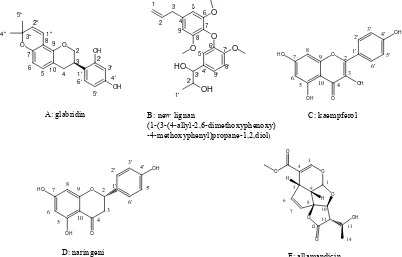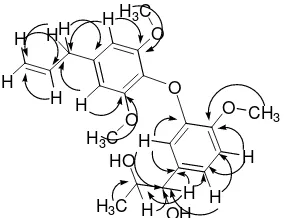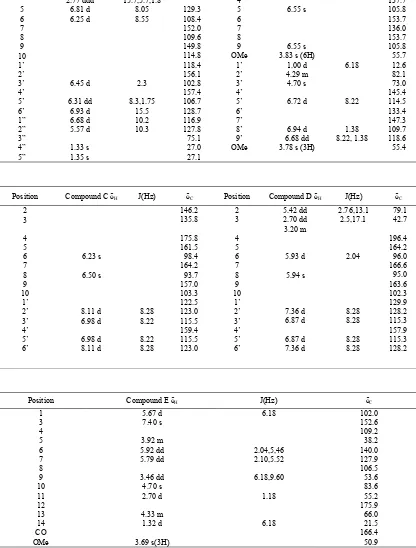doi:10.4236/nr.2011.23022 Published Online September 2011 (http://www.SciRP.org/journal/nr)
Isolation, Identification and Tyrosinase Inhibitory
Activities of the Extractives from Allamanda
cathartica
Kosei Yamauchi1, Tohru Mitsunaga1, Irmanida Batubara2
1Faculty of Applied Biological Science, Gifu university, Gifu, Japan; 2Department of Chemistry, Faculty of Mathematics and Natural Sciences, Biopharmaca Research Center, Bogor Agricultural University, Bogor, Indonesia.
Email: mitunaga@gifu-u.ac.jp, ime ime@ipb.ac.id
Received April 19th, 2011; revised May 12th, 2011; accepted June 4th, 2011.
ABSTRACT
Tyrosinase inhibitory activity of the extractives from A. cathartica was examined and their new bioactivity and potent active compounds were identified. Five compounds, glabridin, new lignan, kaempferol, naringenin, and allamandicin,
were isolated by a series of chromatography, and identified by NMR and LC-MS. Among them, glabridin had the high-est tyrosinase inhibitory activity (IC50:2.93 μM) which is 15 times stronger than that of kojic acid used as positive
con-trol (IC50:43.7 μM). Moreover the lignan was indentified as 1-[3-(4-allyl-2,6-dimethoxyphenoxy)-4-methoxyphenyl] pro-
pane-1,2,diol which was a novel lignan.
Keywords: Allamanda c athartica, Tyrosinase, Glabridin, Kaempferol, Naringenin, Allamandicin
1. Introduction
Allamanda cathartica is a plant cultivated in tropical area. It is used as decoction in various areas and is used in numerous ways. For instance, the extract is used as cathartic in South America and the stem extract is used as antihypertensive in Bangladesh [1-3]. However, the studies of components which have potent bioactivity in this plant are very few, and the mechanisms of the bioac-tivity have not been done sufficiently. Therefore, the aim of this study is to search active compounds from extract of this plant, and reveal the bioactive mechanism. We have been interesting to find the bioactive compounds from tropical plant extracts, and have identified some kinds of natural products relating to health and beauty so far. The present study examined tyrosinase inhibitory activity of the extractives from A. cathartica.
Melanin is a pigment which is biosynthesized from tyrosine by enzymatic oxidation of tyrosinase. Melanin is widely distributed in body surface, retina, nigra of brain, adrenal medullae, and so on. Moreover, it is thought to play an important role in skin cancer prevention by pro-tection of cells from ultraviolent rays. While, it is said that melanin is a reason of sunburn and mottle. Therefore, compounds inhibiting melanin are expected to applica-tion of cosmetic as whitening agent. Melanin is biosyn-
thesized in cells called melanocyte, and the starting ma-terial of biosynthesis is L-tyrosin. The key enzyme of melanin synthesis is tyrosinase which contains copper, and catalyzes two reactions in the melanin biosynthesis. In the cell, first key step of melanin biosynthesis is the oxidation of L-tyrosine to L-DOPA and second step is L-DOPA to L-DOPA quinine, which are catalyzed by tyrosinase. As the result, pheomelanin and eumelanin are produced. Pheomelanin is red-orange color and eumela-nin is blackish brown.
Then, tyrosinase inhibitior makes melanin production diminishing, because the activity of this enzyme is rate-controlling step of melanin synthesis. We found that
A. cathartica stem extract has tyrosinase inhibitory activity, and tried to search the center active compound. Some kind of tyrosinase inhibitors have been already found from plant extract [4-9]. We isolated 5 compounds (Figure 1) from extract of A.cathartica, and glabridin had the highest tyrosinase inhibitory activity among the compounds.
2. Materials and Methods
2.1. Materials
O O
A: glabridin B: new lignan
(1-(3-(4-allyl-2,6-dimethoxyphenoxy) -4-methoxyphenyl)propane-1,2,diol)
C: kaempferol
D: naringeni E: allamandicin
Figure 1. Structure of compound A-E.
1002002.
2.2. Extraction and Fractionation of A. cathartica
Stem Powder
A. cathartica stem powder (385.4 g) was extracted with methanol. The methanol extract was fractionated with ethyl acetate. The ethyl acetate soluble fraction was separated with silica gel column chromatography (69 mm
φ × 510 mm L). Eluted with n-hexane, EtOAc, MeOH to obtain Fr.1-Fr.8. The Fr.3 was separated with preparative HPLC[ODS-3 (20 mm φ × 250 mm L) (MeOH/0.05% TFA aq.soln. = 10/90 (0 min), 100/0 (60 min), 100/0 (80 min)] to obtain Fr.3-1-Fr.3-4. Finally, compound A, B, C, D, and E were isolated from Fr.3-3, Fr.3-1, Fr.3-4, Fr.3-4, and Fr.3-4 respectively by preparative HPLC [ODS-3 (10 mm φ × 250 mm L) (MeOH/0.05% TFA aq.soln. = 10/90 (0 min), 100/0 (60 min), 100/0 (80 min)] (Figure 2).
2.3. Tyrosinase Activity Assay
The tyrosinase activity method performed based on Ba-tubara et al. (2010) [10]. Briefly, sample 70 μl was put in 96-well plate. Tyrosinase 30 μl (333 unit/ml in phosphate buffer 50 mM pH 6.5) and 110 μl of substrates (L-tyro-sine 2mM or L-DOPA 12mM) were added. After incuba-tion at 37˚C for 30 min, the absorbance at 510 nm was determined using a micro plate reader. Moreover IC50
value (concentration of inhibitor showing 50% inhibition) was calculated.
2.4. Identification of Compounds
Compound A-E were identified by 1H-NMR, 13C-NMR,
1
H-1H-COSY, HMQC, HMBC, and LC-MS. Aceton-d6 was used as the solvent for all compounds. These NMR measurements were performed by using JEOL EC600- NMR.LC-MS measurements (Waters Waters®XevoTM QTof MS) was performed using column C18 (2.1 × 100
mm) with MeOH/water = 60/40 (0 min), 100/0 (10 min), 100/0 (13 min) as eluent.
The NMR data of compounds isolated from A. cathar-tica stem is shown in Table 1. LC-MS: ES-data of Compoun A, B, C, D, and E were m/z: 323 (M-1), 373, 285, 271, 307 respectively.
3. Results and Discussion
3.1. Compounds Identification
Allamanda cathartica contains hydrocarbons(long chain esters), e.g. 1-triacontanol, 1-dotriacontanol, docosanoic-, tetracosanoic- and hexacosanoic acid in the root; β -si-tosterol and triterpenes e.g. ursolic acid and β-amyrin in the leaves or stem, and lupeol in the roots [1-3]. Other components isolated from the roots include series of iri-doid lactones: allamadin, allamandicin, plumericin, iso-plumericin, plumeieride and fluvoplumierin [11,12].
P-HPLC Preparative HPLC( P-HPLC)
P-HPLC P-HPLC
Stem powder of A .catharitica(385.4 g)
Insoluble fraction
Extracting with EtOAc 12 h ×3 Residue MeOH extract (ASM) (29.9 g)
Soluble fraction
Silicagel column chromatography ( 69 mmφ×510 mm L)
Fr.3-1 Fr.3-2 Fr.3-3 Fr.3-4 Fr.1 Fr.2 Fr.3 Fr.4 Fr.5 Fr.6 Fr.7 Fr. 8
Extracted with MeOH 12 h ×3
Compound B Compound A Compound C,D,E
Figure 2. Isolation scheme of the compounds from A. catharitica stem powder.
been found in petals of this plant, and allamandicin have been found in roots[4]. However, it was revealed that the two compounds are also contained in stem. Moreover, glabridin and naringenin are found the first time in this plant.
NMR spectrum of glabridin was also searched, and tried to compare to data of compound A and glabridin. The NMR spectrum data from glabridin was similar to that of compound A. Equally, compound C, D, E were identified as keampferol, naringenin, allmandicin respec-tively [13-15].
Compound B was found to be a novel compound. Ac-cording to NMR data for compound B, 5.11 and 5.07ppm protons were geminal and alkene protons because of chemical shift and HMQC data. The two protons of 6.55 ppm peeks were equivalen in aromatic ring protons, be-cause it appeared as singlet proton. The three protons of 6.72, 6.94, 6.68 ppm were also the aromatic protons in-dicating ortho-metha, ortho, and metha coupling. Ac-cording to the HMBC spectrum of compound B (Figure 3), long-range correlations were observed between H-1 and C-2, H-2 and C-1, C-3, C-4, H-3 and C-1, C-2, C-4, H-5 and C-3, C-4, C-6, 6-OMe and C-6, 8-OMe and C-8, H-9 and C-8, C-4, C-3, H3-1’ and C-2’, C-3’, H-2’ and
C-3’, H-3’ and C-4’, C-9’, H-5’ and C-3’, C-4’, C-6’, C-7, 7’-OMe and C-7’, H-8’ and C-7’, C-9’ and between H-9’ and C-8’, C-3’, C-4’. These NMR and MS data showed us the compound B is lignan 1-[3-(4-allyl-2, 6-dimetoxyphenoxy)-4-methoxyphenyl]propane-1,2,diol shown Figure 1.
3.2. Tyrosinase Inhibitory Activity
Allamanda crude extract and the fractions were analyzed for their activity against tyrosinase. The IC50 values of
MeOH extract and fractions are shown in Table 2. Kojic
acid is used as a positive control, because kojic acid is included in whitening agent of cosmetic products. Table 1 shows that IC50 value of MeOH extract is 98.4 μg/ml,
and that of Fr.3 is 8.35 μg/ml. Thus, tyrosinase inhibition is becoming strong with following fractionation. Among to Fr.3-1 till Fr.3-4, Fr.3-3 had the strongest activity (IC50
0.589 μg/ml).
From Fr.3-3, glabridin was isolated. Moreover, from Fr.3-1, lignan was isolated and from Fr.3-4, naringenin, kaempferol, and allamandicin were isolated. Their ty-rosinase inhibitory activity are shown in Table 3. Ac-cording to Table 3, only glabridin has potent activity. The tyrosinase inhibitory activity of glabridin is shown in
Figure 4 for L-tyrosine as substrate and Figure 5 for L-DOPA as substrate. According to Figure 4, glabridin had about 93% of tyrosinase inhibition at concentration 19.3 μM for reaction with L-tyrosine as substrate. While, Kojic acid had only about 28% inhibition at 54.9 μM con-centration. IC50 value of glabridin was 2.93 μM, and this
value was lower than that of Kojic acid value (43.7 μM). Moreover, in Figure 5 (tyrosinase inhibitory activity using DOPA as the substrate), IC50 value of glabridin
was 25.5 μM, and this value was lower than that of Kojic
O
O H3C
H3C
O CH3
OH HO
H3C
O
H
H H
H HH
H H
H
H
H H
Table 2. Tyrosinase inhibitory activity of extract and fractions from A. cathartica stem.
Kojic acid
MeOH
extract Fr.1 Fr.2 Fr.3 Fr.4 Fr.5 Fr.6 Fr.7 Fr.8
IC50(μg/ml) 6.18 98.4 100< 95.7 8.35 89.1 100< 100< 100< 100<
Fr.3-1 Fr.3-2 Fr.3-3 Fr.3-4
IC50(μg/ml) 100< 56.6 0.589 100<
Table 3. Tyrosinase inhibitory activity of compounds isolated from A. cathartica stem.
compounds Kojic acid Glabridin Lignan Kaempferol Naringenin Allmandicin
IC50(μM) 43.7 2.93 100< 100< 100< 100<
Figure 4. Tyrosinase inhibitory activity of glabridin using tyrosine as the substrate.
Figure 5. Tyrosinase inhibitory activity of glabridin using DOPA as the substrate.
acid value 298 μM. Tyrosinase inhibitory activity of glabridin was more than 10 times stronger than that of kojic acid. Thus, glabridin is the center active compound, and possibly has a potent activity for cosmetic as whit-ening agent.
4. Conclusions
In this study, 5 compounds were newly found in A.
ca-tharitica stem, namely glabridin, new lignin, naringenin, kaempferol and allamandicin. Among all the isolated compounds, glabridin has the most potent tyrosinase in-hibitory activity.
REFERENCES
Medicinal and Poisonous Plants 2,” Plant Resources of South-East Asia (PROSEA), Bogor, 2002, pp. 49-52. [2] P. A. Akah and V. N. Offiah, “Gastrointestinal Effects of
Allamanda Cathartica Leaf Extracts,” International Journal of Pharmacognosy, Vol. 30, No. 3, 1992, pp. 213- 217.doi:10.3109/13880209209054001
[3] M. J. Balunas and A. D. Kinghorn, “Drug Discovery from Medicinal Plants,” Life Sciences, Vol. 78, No. 5, 2005, pp. 431-441.doi:10.1016/j.lfs.2005.09.012
[4] S. Khatib, O. Nerya, R. Musa, M. Shmuel, S. Tamir and J. Vaya, “Chalcones as Potent Tyrosinase Inhibitors: The Importance of a 2,4-Substituted Resorcinol Moiety,” Bioorganic & Medicinal Chemistry, Vol. 13, No. 2, 2005, pp. 433-441.doi:10.1016/j.bmc.2004.10.010
[5] O. Nerya, R. Musa, S. Khatib, S. Tamir and J. Vaya, “Chalcones as Potent Tyrosinase Inhibitors: The Effect of Hydroxyl Positions and Numbers,” Phytochemistry, Vol. 65, No. 10, 2004, pp. 1389-1395.
doi:10.1016/j.phytochem.2004.04.016
[6] Z.-P. Zheng, K.-W. Cheng, J. Chao, J. Wu and M. Wang, “Tyrosinase Inhibitors from Paper Mulberry (Broussone- tia Papyrifera),” Food Chemistry, Vol. 106, No. 2, 2008, pp. 529-535.doi:10.1016/j.foodchem.2007.06.037
[7] C. Okunji, S. Komarnytsky, G. Fear, A. Poulev, D. M. Ribnicky, P. I. Awachie, Y. Ito and I. Raskin, “Prepara-tive Isolation and Identification of Tyrosinase Inhibitors from the Seeds of Garcinia Kola by High-Speed Counter- Current Chromatography,” Journal of Chromatography A, Vol. 1151, No. 1-2, 2007, pp. 45-50.
doi:10.1016/j.chroma.2007.02.085
[8] Azhar-ul-Haq, A. Malik, M. T. H. Khan, Anwar-ul-Haq, S. B. Khan, A. Ahmad and M. I. Choudhary, “Tyrosinase Inhibitory Lignans from the Methanol Extract of the Roots of Vitex Negundo Linn. and Their Structure-Acti-
vity Relationship,” Phytomedicine, Vol. 13, No. 4, 2006, pp. 255-260.doi:10.1016/j.phymed.2004.09.001
[9] M.-H. Lee, Y.-P. Lin, F.-L. Hsu, G.-R. Zhan and K.-Y. Yen, “Bioactive Constituents of Spatholobus Suberectus in Regulating Tyrosinase-Related Proteins and mRNA in HEMn Cells,” Phytochemistry, Vol. 67, No. 12, 2006, pp. 1262-1270.doi:10.1016/j.phytochem.2006.05.008
[10] I. Batubara, L. K. Darusman, T. Mitsunaga, M. Rah-miniwati and E. Djauhari, “Potency of Indonesian Me-dicinal Plants as Tyrosinase Inhibitor and Antioxidant Agent,” Journal Biological Sciences, Vol. 10, No. 2, 2010, pp. 138-144.doi:10.3923/jbs.2010.138.144
[11] S. M. Kupchan, A. L. Dessertme, B. T. Blaylock and R. F. Bryan, “Isolation and Structural Elucidation of mandin, and Antileukemic Iridoid Lactone from Alla-manda Cathartica,” The Journal of Organic Chemistry, Vol. 39, No. 17, 1974, pp. 2477-2482.
doi:10.1021/jo00931a001
[12] J. J. W. Coppen and A. L. Cobb, “The Occurrence of Iri-doids in Plumeria and Allamanda,” Phytochemistry, Vol. 22, No. 1, 1983, pp. 125-128.
doi:10.1016/S0031-9422(00)80071-0
[13] J. J. W. Coppen, “Iridoids with Algicidal Properties from Allamanda Cathartica,” Phytochemistry, Vol. 22, No. 1, 1983, pp. 179-182. doi:10.1016/S0031-9422(00)80083-7
[14] R. Singh, B. Singh, S. Singh, N. Kumar, S. Kumar and S. Arora, “Anti-Free Radical Activities of Kaempferol Iso-lated from Acacianilotica (L.) Willd. Ex. Del.,” Toxicol-ogy in Vitro, Vol. 22, No. 8, 2008, pp. 1965-1970.
doi:10.1016/j.tiv.2008.08.007



